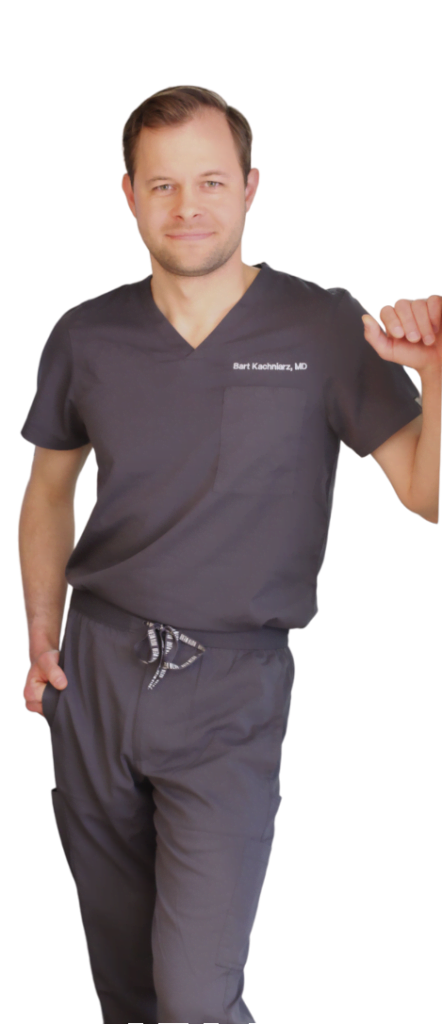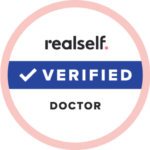Breast
Augmentation
- Miami -
overview
Are you looking for a change? Perhaps you feel like your breasts are too small, lopsided or just do not have the right look. You are not alone.
It’s estimated that 71% of women are not content with their breasts, with 47% looking for bigger breasts. While aesthetic plastic surgery is not the answer to all your problems, it can help you get back your self-confidence.
Dr. Bart Kachniarz is Miami’s top breast augmentation surgeon, with the skill set and latest technology to guide you in your transformation. Please contact us for a free consultation to explore your breast augmentation options.


What Is Breast Augmentation?
Breast augmentation (or “augmentation Mammaplasty”) is an outpatient cosmetic procedure that enhances the natural form and volume of the breast. It utilizes a combination of implants and/or the patient’s own fat tissue to achieve a natural breast aesthetic, and create a harmonious, feminine physique.
This procedure helps restore lost volume, particularly in the upper aspects of the breast, which may have been lost following pregnancy or weight loss.
It can also correct breast asymmetry, especially when combined with a breast lift procedure as well as enhances the fullness of the breast, offers a more balanced feminine physique, and can serve as a transformational confidence boost.
Breast augmentation is the most frequently performed plastic surgery procedure in the United States, and its popularity continues to grow. Many women opt for breast enlargement to enhance a naturally small chest or to address sagging and volume loss associated with aging, weight loss, pregnancy, or breastfeeding. It’s one of the most popular cosmetic surgeries, with the number of procedures increasing year-on-year.
Who Is a Good Candidate?
Ideal candidate are patients that:
- Is interested in improving the size and shape of their breasts
- Is generally healthy, without medical conditions that could impair healing
- Does not smoke or is willing to stop smoking before the procedure
- Has a thorough understanding of the risks and benefits of cosmetic surgery
- Has no recent changes in breast size and shape (e.g., from weight loss or breastfeeding)
During your consultation, Dr. K will guide you through all of your options and help you decide whether breast augmentation is the right fit for you.
Benefits
- Enhanced Confidence and Self-Esteem
Breast augmentation can help individuals feel more confident about their appearance, boosting self-esteem and body image. - Improved Body Proportion
Augmentation helps achieve a more balanced silhouette, harmonizing the body’s proportions and enhancing overall aesthetics. - Restored Volume After Pregnancy or Weight Loss
It can restore lost breast volume that often occurs after pregnancy, breastfeeding, or significant weight loss. - Correction of Asymmetry
Breast implants can correct uneven breasts, providing a more symmetrical and balanced look. - Youthful Appearance
Augmentation can give the chest a firmer, more youthful appearance, combating the effects of aging or sagging. - Clothing Fit Improvement
Enhanced breast size and shape can make clothes, swimsuits, and lingerie fit better and look more flattering. - Post-Mastectomy Reconstruction
Breast augmentation can be a key part of reconstructive surgery after a mastectomy, helping individuals feel whole again. - Boost in Feminine Identity
Many individuals feel that breast augmentation enhances their sense of femininity and personal identity, aligning their external appearance with how they feel inside.

Types of Breast Implants
The two main types of breast implants, based on their filler material, are saline and silicone.
Saline breast implants are filled with a sterile saltwater solution, while silicone breast implants contain a cohesive gel that closely mimics the feel of natural breast tissue. It’s important to note that silicone implants require periodic MRI screenings to detect any potential implant leaks or ruptures.
Breast implants also come in different shapes, with round and teardrop (anatomical) being the most common options. Round implants provide a fuller projection at the upper portion of the breasts, while teardrop implants mimic the sloped curve of a natural breast, offering a more subtle and naturalistic look.
The choice between these shapes often depends on the patient’s desired outcome and their existing breast tissue.
Saline vs Silicone Implants
While both types of implants share a similar outer silicone shell, they are filled with distinct materials that dictate their properties. Silicone implants contain a silicone gel of variable cohesivity that mimics natural breast tissue, whereas saline implants are inserted while deflated, and subsequently filled with medical-grade saline.
Silicone breast implants have a more natural look and feel compared to their saline counterparts. The cohesive silicone gel tends to “ripple” and distort less along the upper aspect of the breast and provides more fullness.
This is particularly true among thinner patients, or when placed above the chest muscle.
Furthermore, modern silicone implants come in a wide variety of cohesivities that afford plastic surgeons greater nuance in individualizing results. Less-cohesive implants tend to have a more natural feel and teardrop shape when upright.


Meet Your Doctor
With years of experience in the field of plastic surgery, Dr. K has built a reputation as one of Miami’s premier plastic surgeons.
His journey into medicine began with a passion for helping others and a keen eye for detail—qualities that have defined his career ever since, but what truly sets him apart is his genuine care for each patient who walks through our doors.
SEE WHAT WE CAN DO FOR YOU
What Are Gummy Bear Implants?
Gummy Bear implants are a type of high-cohesivity silicone implant, and are among the latest technology within the Natrelle lineup. These implants optimize upper breast fullness and minimize “rippling” of the skin.
They also minimize any leakage within the implant pocket in case of implant shell rupture.
Gummy Bear implants are highly cohesive and optimize upper breast fullness while providing a smooth, shapely cleavage. Saline implants have the advantage of being placed through a slightly smaller incision, since they are inflated while inside the breast pocket.
They also generally do not require imaging surveillance for rupture; ruptured saline implants deflate in size and are readily noticeable.
You may discuss whether Gummy Bear implants are the right fit for you during your complementary consultation.

Natural Breast Augmentation
For women seeking a more subtle breast enhancement, natural breast augmentation, also known as fat transfer breast augmentation, could be a viable option. This technique involves harvesting excess fat from areas like the abdomen, hips, or thighs through liposuction.
The purified fat is then carefully injected into the breasts to add natural-looking volume and improve breast shape. However, it’s important to note that the main limitation of this method is that it typically allows for an increase of only about one cup size.

How Do You Select Your Implant Size?
The most valuable technique in selecting your implant size is using specifically-designed implant sizers. These are shaped silicone inserts that allows you to “try on” different sized implants. You will have an opportunity to actually feel the fullness and volume of your new breasts.
During your consultation, Dr. Kachniarz will also take careful measurements of each breast to ensure perfect fit of the final implant.

Where Is the Incision made?
In the vast majority of patients, the incision is placed within the inferior fold of the breast, also called the inframammary fold approach. This technique provides the most direct access to the implant pocket with minimal disruption of native breast tissue.
It has also been shown to carry the lowest risk of capsular contracture; the incision hides seamlessly within the breast fold.
Other less-commonly used approaches include the edge of the areola, armpit, and belly button. These techniques each have advantages that you may discuss with Dr. Kachniarz at your complementary consultation.
Implant Placement Options
There are two main implant placement options: subglandular and submuscular breast augmentation. In subglandular placement, the prosthesis is placed behind the mammary gland, between the breast tissues and the pectoral muscle. This is ideal for those with adequate breast tissue, so the implant doesn’t look artificial.
In submuscular placement, they are placed below the pectoral muscle, being entirely covered by it. This offers very natural results in sight and touch, especially for women with very little breast tissue. The plastic surgeon makes a small incision in the lower chest area, so visible scarring is minimal under the natural fold.
Are Implants Placed Above or Below the Muscle?
Breast implants are placed either above or, at least partially, below the pectoralis major muscle. We’ll discuss the benefits of each approach and help you select the option that best suits your body and lifestyle.
Breast implants that are placed partially under the pectoralis muscle is known as a Dual-Plane technique. The muscle over the upper aspect of the breast masks the shape of the underlying implant and provides for a more naturally-sloping shape.
The muscle also masks any “rippling” or distortion of the implant, which is particularly important in thinner patients or when using low-cohesivity or saline implants. Implants placed under the muscle have also been shown to have lower rates of capsular contracture, which occurs when a tight layer of scar tissue forms around the implant.
Implants may also be placed above the muscle, and underneath the breast tissue. This greatly speeds up recovery, as the pectoralis muscle remains undisturbed. This technique also preserves native muscle function and eliminates the risk of animation deformity, which is particularly helpful among physically active patients.
Animation deformity may occur when the contracting pectoralis muscle pushes on the underlying breast implant. Implants placed above the muscle may be more visible; this may be alleviated with careful fat transfer to better mask the implant and provide a natural upper breast form.

What To Expect on the Day of Surgery?
Our experienced team will guide you in preparation for your breast augmentation surgery. Your safety is our top priority, which is why all procedures are performed at an accredited ambulatory surgery center.
For procedures performed under general anesthesia, you will need to see your primary care doctor for an examination and obtain basic bloodwork.
Breast surgery is typically performed under general anesthesia, although it can be done while awake. You can discuss the best option for you during your complimentary consultation.
The cosmetic procedure takes approximately two hours, and you’ll go home the same day. Dr. Kachniarz will call you the evening after your procedure to check in and answer any questions that may have come up. You will have 24/7 access to your surgeon following your procedure.
Recovery and Results
Recovery depends largely on whether the implant was placed under or above the muscle. Patients with implants placed under the muscle will note a degree of muscle tightness, which can last a couple of weeks.
This sensation is greatly relieved by muscle relaxants, which are usually prescribed prior to your procedure. Implants placed above the muscle tend to have a much faster recovery, which is generally limited to surgical site tenderness and recovery from anesthesia.
Potential Risks and Complications
As with any surgical procedure, surgery carries certain risks and potential complications. While these risks can be minimized by choosing an experienced, board-certified plastic surgeon and following all pre- and post-operative instructions, it’s essential to be aware of them.
Some potential risks and complications associated with breast augmentation include infection, bleeding, fluid accumulation, persistent pain, unfavorable scarring, poor wound healing, breast asymmetry, and injury to the nipple or surrounding tissue.
In rare cases, implant rupture or capsular contracture (hardening of the scar tissue around the implant) may occur, necessitating additional surgical intervention.
How Much Does Breast Augmentation Cost in Miami?
Breast augmentation surgery in Miami costs approximately $6,000 – $12,000 using implants, and approximately $8,000 – $12,000 using your own fat transfer.
You may schedule a complementary consultation to obtain an individualized surgical quote.
Surgical pricing is all-inclusive; it covers the surgeon fees, facility and anesthesia fees, implants, sizers, Keller funnel, a Marena postsurgical garment, and a supplemental CosmetAssure insurance policy.
We never charge hidden fees.
Can You Perform Breast Augmentation Using Your Own Fat?
Yes, fat transfer breast augmentation is an excellent option for patients desiring a more modest increase in volume and a natural, long-lasting result.
Most frequently, the abdomen, waist, and flanks are liposculpted to obtain fat tissue for the transfer. To optimize fat survival, the REVOLVE system is used to purify the fat prior to transfer.
For patients who desire higher volume augmentation, fat transfer may be combined with implant placement to provide a more natural upper breast shape and better conceal the implant.
Dr. Kachniarz will help you decide whether this is the right option for you during your complimentary consultation.
Is Breast Surgery Painful?
Placement of implants above the muscle yields a more rapid recovery, often limited to postsurgical tenderness that generally subsides after a few days to a week.
Placement of implants underneath the muscle does result in more chest muscle tightness, which may take a couple of weeks to resolve.
Muscle relaxants frequently help alleviate tightness as the muscle grows accustomed to the new implant position.
Full healing of the area may take up to six weeks, and the procedure incision will continue to mature and fade for up to a year.
Can You Combine Breast Augmentation Surgery With Other Procedures?
Yes, breast augmentation is often combined with other aesthetic procedures. The two most common procedures performed alongside augmentation are a breast lift and tummy tuck. This combination is often referred to as a “Mommy Makeover,” addressing changes in the breasts and abdomen following pregnancy.
You can discuss your individualized treatment plan with Dr. Kachniarz during your complimentary consultation.
FAQs
How Long Does Surgery Take?
On average, a breast augmentation procedure with implants takes about two hours, while that using your own fat takes approximately 3-4 hours depending on the areas undergoing liposculpture.
After the procedure, patients recover from anesthesia in the postoperative care unit and are discharged home the same day.
What Is Capsular Contracture?
Capsular contracture occurs when a layer of scar tissue forms, encapsulating the breast implant.
With more advanced degrees of capsular contractures, the breast may feel hardened, appear distorted, or even become painful. Although studies are ongoing regarding the exact pathophysiology behind capsular contracture, there appears to be a contribution from low-level bacterial contamination.
To minimize this risk, Dr. Kachniarz utilizes the latest aseptic techniques, including Keller funnels, single-use sizers, a no-touch technique, and antibiotic irrigation.
In cases of capsular contracture, a revision breast augmentation procedure may help remove scar tissue and place the affected implants in a fresh position.
How Many Cup Sizes Can You Go Up?
The increase in breast volume you can safely achieve during augmentation largely depends on your individual anatomy and will be discussed at your consultation visit.
The best predictor of how your new breast size will feel inside a bra is using our specialized implant sizers. Unfortunately, cup sizes are not a standardized measure of breast size, and vary significantly between brands.
As such, we focus on enhancing your physique and providing a natural-looking result, rather than aiming for a specific cup-size increase.
Can I Receive a Breast Surgery Again in the Future?
Yes, you can undergo breast augmentation in the future if you wish to change your implant size or shape.
Most patients who undergo surgery will require a revision procedure at some point, which may include replacement of implants.
How Often Do I Have To Get My Implants Replaced?
Breast implants are often quoted to have a 10-15 year lifespan on average.
This doesn’t necessarily mean you have to replace your implants at that interval. Indications for replacing implants include leakage or shell rupture, which is readily visible with saline-filled implants, and assessed via surveillance imaging for silicone implants.
Implants may also need to be replaced if they shift position or change shape over time. Ultimately, the need to replace your implants will be discussed during consultation with Dr. Kachniarz.
Will There Be Any Loss of Sensation in My Breasts After Surgery?
It’s quite common to have temporary changes in sensation following surgery as the surrounding tissues stretch over the implant and heal.
This may include areas of temporary numbness, tingling, or nipple sensitivity, which generally resolves over the course of a few weeks to months.
Very rarely, there may be permanent changes in sensation to the breast following surgery.
References
- American Society of Plastic Surgeons. https://www.plasticsurgery.org/cosmetic-procedures/breast-augmentation
- Mayoclinic. https://www.mayoclinic.org/tests-procedures/breast-augmentation/about/pac-20393178
- National Library of Medicine. https://www.ncbi.nlm.nih.gov/pmc/articles/PMC2825138/
- Springer. https://link.springer.com/article/10.1007/s00266-022-02904-9
